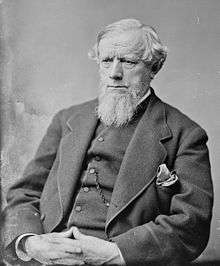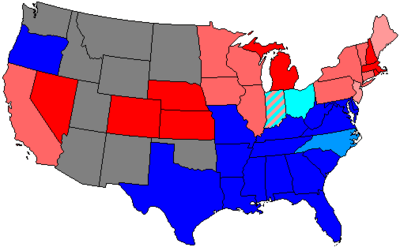46th United States Congress
| 46th United States Congress | |||||||||||||||||||||||||||||
| |||||||||||||||||||||||||||||
The Forty-sixth United States Congress was a meeting of the legislative branch of the United States federal government, consisting of the United States Senate and the United States House of Representatives. It met in Washington, D.C. from March 4, 1879 to March 4, 1881, during the last two years of the administration of U.S. President Rutherford B. Hayes.
The apportionment of seats in this House of Representatives was based on the Ninth Census of the United States in 1870. The Senate had a Democratic majority, while the House of Representatives had a Democratic plurality. The Democrats were still able to control the House, however, with the help of the Independent politicians who caucused with them.
Party summary
Senate
| Party (shading shows control) |
Total | Vacant | |||||
|---|---|---|---|---|---|---|---|
| Anti- Monopoly (AM) |
Democratic (D) | Republican (R) | Independent (I) | Other | |||
| End of the previous congress | 1 | 36 | 38 | 1 | 0 | 76 | 0 |
| Begin | 1 | 42 | 31 | 1 | 0 | 75 | 1 |
| End | |||||||
| Final voting share | 1.3% | 56.0% | 41.3% | 1.3% | 0.0% | ||
| Beginning of the next congress | 0 | 37 | 36 | 1 |
1 (Readjuster) |
75 | 1 |
House of Representatives
| Party (shading shows control) |
Total | Vacant | |||||
|---|---|---|---|---|---|---|---|
| Democratic (D) |
Independent Democratic (ID) | Independent (I) | National Greenback (NG) | Republican (R) | |||
| End of the previous congress | 154 | 1 | 0 | 0 | 136 | 291 | 2 |
| Begin | 145 | 4 | 1 | 11 | 131 | 292 | 1 |
| End | 146 | 129 | 291 | 2 | |||
| Final voting share | 50.2% | 1.4% | 0.3% | 3.8% | 44.3% | ||
| Beginning of the next congress | 128 | 1 | 1 | 10 | 151 | 291 | 0 |
Leadership

William A. Wheeler


Senate
House of Representatives
- Speaker: Samuel J. Randall (D)
Major events
- Depression of 1873–79
- March 18, 1879: Samuel J. Randall was elected in one of the most tightly fought contests for the speakership after the Civil War. Randall, who favored the protective tariff and "hard money," drew his greatest strength from northern cities and greatest opposition from the west and south. The midterm elections of 1878 had gone badly for the Democrats, with the Greenback Party making inroads in key districts. This emboldened Randall's opponents, who rallied to the support of Joseph Blackburn from Kentucky. In the end, Randall prevailed in the Democratic caucus to receive the nomination, with 75 votes to Blackburn's 57 and a scattering of 9 votes to three other candidates. Blackburn, in moving to make Randall's nomination unanimous, steered his supporters away from the nomination of Hendrick B. Wright, a Democrat from Pennsylvania who was nominated by the Greenbacks. In the eventual vote in the House to elect the Speaker, Randall prevailed with 144 votes, to 125 for James Garfield (Republican from Ohio), 13 for Wright, and one for William "Pig Iron" Kelley (Pennsylvania).
- November 2, 1880: U.S. presidential election, 1880: James Garfield (R) defeated Winfield S. Hancock (D)
- February 19, 1881: Kansas became the first state to prohibit alcohol.
Major legislation
- [Data unknown/missing. You can help!]
Members
This list is arranged by chamber, then by state. Senators are listed in order of seniority, and Representatives are listed by district.
Senate
Preceding the names in the list below are Senate class numbers, which indicate the cycle of their election. In this Congress, Class 1 meant their term ended with this Congress, requiring re-election in 1880; Class 2 meant their term began in the last Congress, requiring re-election in 1882; and Class 3 meant their term began in this Congress, requiring re-election in 1884.
House of Representatives
The names of members are preceded by their district numbers.
Changes in membership
The count below reflects changes from the beginning of the first session of this Congress.
Senate
- replacements: 4
- Democratic: no net change
- Republican: no net change
- deaths: 3
- resignations: 1
- interim appointments: 2
- Total seats with changes: 5
| State (class) |
Vacator | Reason for change | Successor | Date of successor's formal installation |
|---|---|---|---|---|
| New Hampshire (3) | Vacant | Legislature had failed to elect. An interim successor was appointed March 13, 1879. |
Charles H. Bell (R) | March 13, 1879 |
| New Hampshire (3) | Charles H. Bell (R) | Successor elected June 18, 1879, but did not begin service until June 20, 1879 for unknown reasons. | Henry W. Blair (R) | June 20, 1879 |
| Michigan (1) | Zachariah Chandler (R) | Died November 1, 1879. Successor appointed November 17, 1879 to continue the term. Appointee was elected January 19, 1881 to finish the term. |
Henry P. Baldwin (R) | November 17, 1879 |
| Alabama (3) | George S. Houston (D) | Died December 31, 1879. Successor appointed January 7, 1880 to continue the term. |
Luke Pryor (D) | January 7, 1880 |
| Georgia (3) | John B. Gordon (D) | Resigned May 26, 1880 to promote building of the Georgia Pacific Railway. Successor elected May 26, 1880. |
Joseph E. Brown (D) | May 26, 1880 |
| Alabama (3) | Luke Pryor (D) | Successor elected November 23, 1880. | James L. Pugh (D) | November 24, 1880 |
| Wisconsin (3) | Matthew H. Carpenter (R) | Died February 24, 1881. | Vacant | Not filled this term |
House of Representatives
- replacements: 8
- Democratic: 1 seat net gain
- Republican: 1 seat net loss
- deaths: 4
- resignations: 3
- contested election: 2
- Total seats with changes: 11
| District | Vacator | Reason for change | Successor | Date successor seated |
|---|---|---|---|---|
| Texas 6th | Vacant | Rep. Gustav Schleicher died during previous congress | Christopher C. Upson (D) | April 15, 1879 |
| New York 12th | Vacant | Rep.-elect Alexander Smith died during previous congress | Waldo Hutchins (D) | November 4, 1879 |
| Iowa 5th | Rush Clark (R) | Died April 29, 1879 | William G. Thompson (R) | October 14, 1879 |
| Missouri 7th | Alfred M. Lay (D) | Died December 8, 1879 | John F. Philips (D) | January 10, 1880 |
| New York 32nd | Ray V. Pierce (R) | Resigned September 18, 1880 | Jonathan Scoville (D) | November 12, 1880 |
| Alabama 6th | Burwell B. Lewis (D) | Resigned October 1, 1880 to accept presidency of the University of Alabama | Newton N. Clements (D) | December 8, 1880 |
| Ohio 19th | James A. Garfield (R) | Resigned November 8, 1880 | Ezra B. Taylor (R) | December 13, 1880 |
| New Hampshire 3rd | Evarts W. Farr (R) | Died November 30, 1880 | Ossian Ray (R) | January 8, 1881 |
| Florida 2nd | Noble A. Hull (D) | Lost contested election January 22, 1881 | Horatio Bisbee, Jr. (R) | January 22, 1881 |
| North Carolina 1st | Joseph J. Martin (R) | Lost contested election January 29, 1881 | Jesse J. Yeates (D) | January 29, 1881 |
| New York 9th | Fernando Wood (D) | Died February 14, 1881 | Vacant | Not filled this term |
| Michigan 7th | Omar D. Conger (R) | Resigned March 3, 1881 after being elected to the US Senate | Vacant | Not filled this term |
Committees
Lists of committees and their party leaders.
Senate
- Additional Accommodations for the Library of Congress (Select)
- Agriculture
- Appropriations
- Audit and Control the Contingent Expenses of the Senate
- Cabinet Officers on the Floor of the Senate (Select)
- Civil Service and Retrenchment
- Claims
- Commerce
- Distributing Public Revenue Among the States (Select)
- District of Columbia
- Education and Labor
- Elections of 1878 (Select)
- Emigration of Negroes from the South to North (Select)
- Engrossed Bills
- Enrolled Bills
- Epidemic Diseases (Select)
- Examine the Several Branches in the Civil Service (Select)
- Finance
- Foreign Relations
- Freedman's Savings and Trust Company (Select)
- Indian Affairs
- Indian Territory (Select)
- Manufactures
- Military Affairs
- Mines and Mining
- Mississippi River and its Tributaries (Select)
- Naval Affairs
- Nicaraguan Claims (Select)
- Ordnance and War Ships (Select)
- Patents
- Pensions
- Plueropneumonia among Animals (Select)
- Post Office and Post Roads
- Private Land Claims
- Privileges and Elections
- Public Lands
- Railroads
- Revision of the Laws
- Revolutionary Claims
- Rules
- Tariff Regulation (Select)
- Tenth Census (Select)
- Territories
- Transportation Routes to the Seaboard (Select)
- Treasury Department Account Discrepancies (Select)
- Whole
House of Representatives
- Accounts
- Alcoholic Liquor Traffic (Select)
- Agriculture
- Appropriations
- Banking and Currency
- Claims
- Coinage, Weights and Measures
- Commerce
- District of Columbia
- Education and Labor
- Elections
- Enrolled Bills
- Expenditures in the Interior Department
- Expenditures in the Justice Department
- Expenditures in the Navy Department
- Expenditures in the Post Office Department
- Expenditures in the State Department
- Expenditures in the Treasury Department
- Expenditures in the War Department
- Expenditures on Public Buildings
- Foreign Affairs
- Indian Affairs
- Invalid Pensions
- Judiciary
- Levees and Improvements of the Mississippi River
- Manufactures
- Mileage
- Military Affairs
- Militia
- Mines and Mining
- Naval Affairs
- Pacific Railroads
- Patents
- Pensions
- Post Office and Post Roads
- Public Buildings and Grounds
- Public Expenditures
- Public Lands
- Railways and Canals
- Revision of Laws
- Rules (Select)
- Standards of Official Conduct
- Territories
- War Claims
- Ways and Means
- Whole
Joint committees
- Budget Control
- Conditions of Indian Tribes (Special)
Employees
- Architect of the Capitol: Edward Clark
- Librarian of Congress: Ainsworth Rand Spofford
- Public Printer of the United States: John D. Defrees
Senate
- Secretary: George C. Gorham
- John C. Burch elected March 24, 1879
- Sergeant at Arms: John R. French
- Richard J. Bright, elected March 23, 1879
- Chaplain: Joseph J. Bullock (Presbyterian)
House of Representatives
- Clerk: George M. Adams
- Sergeant at Arms: John G. Thompson
- Doorkeeper: Charles W. Field
- Postmaster: James M. Steuart
- Clerk at the Speaker’s Table: J. Randolph Tucker, Jr.
- George P. Miller
- Michael Sullivan
- Chaplain: W.P. Harrison (Methodist)
See also
- United States elections, 1878 (elections leading to this Congress)
- United States elections, 1880 (elections during this Congress, leading to the next Congress)
References
- Martis, Kenneth C. (1989). The Historical Atlas of Political Parties in the United States Congress. New York: Macmillan Publishing Company.
- Martis, Kenneth C. (1982). The Historical Atlas of United States Congressional Districts. New York: Macmillan Publishing Company.
External links
- Biographical Directory of the U.S. Congress
- U.S. House of Representatives: House History
- U.S. Senate: Statistics and Lists
- Congressional Directory for the 46th Congress, 1st Session.
- Congressional Directory for the 46th Congress, 2nd Session.
- Congressional Directory for the 46th Congress, 2nd Session (Revision).

